Spatial OMICS Market Size
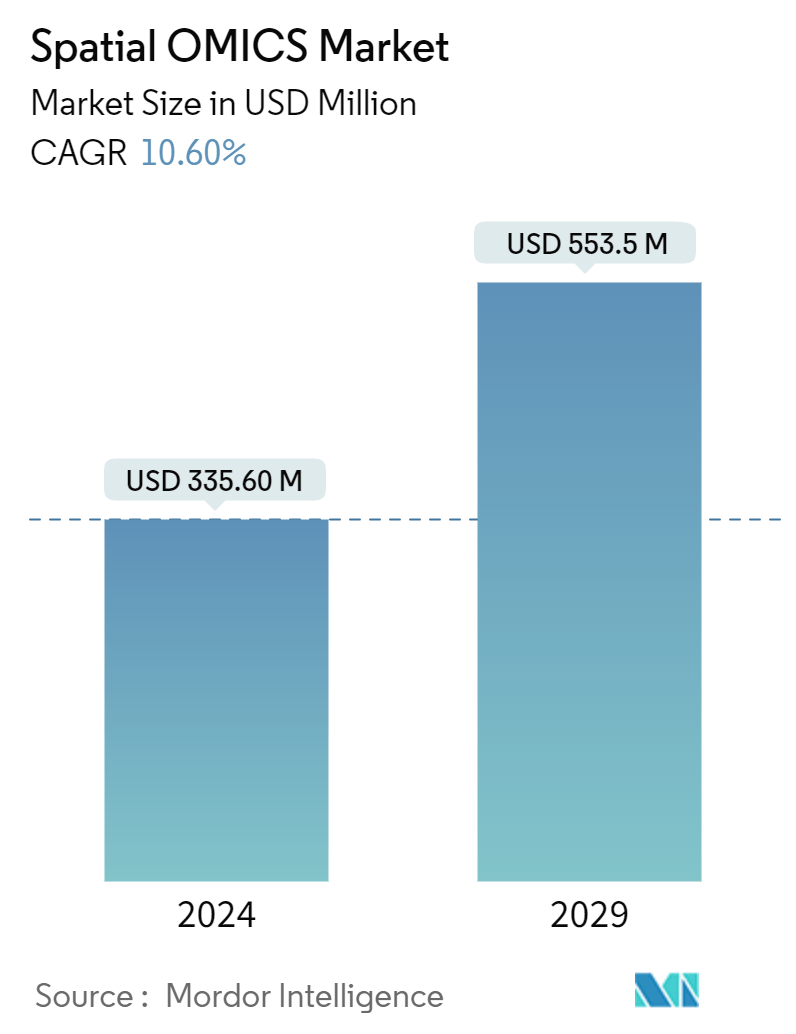
| Study Period | 2021 - 2029 |
| Market Size (2024) | USD 335.60 Million |
| Market Size (2029) | USD 553.5 Million |
| CAGR (2024 - 2029) | 10.60 % |
| Fastest Growing Market | Asia Pacific |
| Largest Market | North America |
Major Players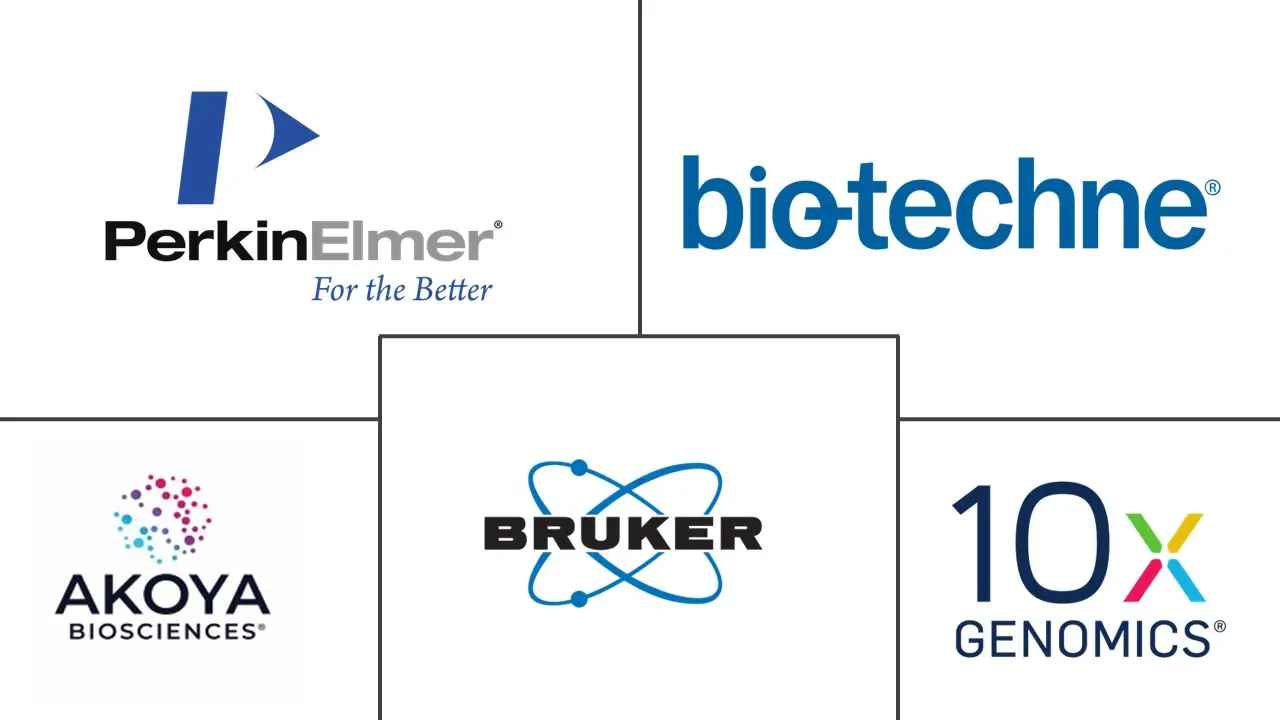
*Disclaimer: Major Players sorted in no particular order |
Spatial OMICS Market Analysis
The Spatial OMICS Market size is estimated at USD 335.60 million in 2024, and is expected to reach USD 553.5 million by 2029, growing at a CAGR of 10.60% during the forecast period (2024-2029).
Major factors, including the rising incidence of cancer, genetic illnesses, and rare diseases, global advances in sequencing technologies, and increased financing for OMICS research drive the market.
The growing burden of cancer is expected to boost the spatial omics market as spatial omics techniques provide detailed information about the molecular and cellular characteristics of cancer and genetic diseases, including genetic mutations, protein expression patterns, and cellular interactions. For instance, according to the data updated by the Spanish Network of Cancer Registries (REDECAN) in January 2023, an estimated 279,260 new cases of cancer were expected to occur in Spain by the end of 2023, out of which 42,721 new cases of colorectal cancer, 31,282 cases of lung cancer, and 21,694 cases of urinary bladder cancer were expected to occur in Spain in 2023. Thus, the growing burden of cancer and the rising demand for precision medicine approaches, especially for genetic diseases, cancer, and rare diseases, is anticipated to create lucrative opportunities for market growth.
Moreover, increasing funding activities for spatial OMICS research is expected to contribute to the growth of the market as spatial OMICS funding contributes to the drug development pipeline by identifying potential drug targets, validating drug efficacy, and assessing drug distribution within tissues. For instance, in June 2023, Owkin Inc. contributed USD 50 million and joined forces with NanoString Technologies Inc. and research teams from European and American institutions and other organizations to use this technology for cutting-edge cancer research. Similarly, in November 2023, Stellaromics announced that the company had raised USD 25 million in a Series A financing round to advance 3D spatial multi-omic profiling. Such funding activities may lead to an increase in research and development activities and expand the application of OMICS for chronic diseases.
Further, technological advancement in spatial OMICS technology and product launches by the market players and engaged strategic activities such as partnerships and collaborations create lucrative opportunities for market growth. For instance, in November 2023, 10x Genomics and Owkin collaborated to add 10x Genomics single-cell technologies and spatial OMICS for the MOSAIC project. Similarly, in September 2023, Bruker reported advancements in instrumental methods, software, and consumables for 4D-Proteomics, 4D-Lipidomics MALDI HiPLEX-IHC spatial tissue proteomics, and 4D-Metabolomics.
Therefore, the growing burden of genetic diseases, cancer, and rare diseases underscores the importance of spatial OMICS technologies in advancing research, diagnostics, and therapeutic interventions, growing funding initiatives, and strategic activities by the market players, driving the demand and adoption of these innovative molecular analysis tools.
However, the high cost of OMICS instruments and data storage, stringent regulatory requirements, and standardization issues are expected to hamper the growth of the market over the forecast period.
Spatial OMICS Market Trends
The Spatial Transcriptomics Segment is Expected to Hold a Significant Market Share Over the Forecast Period
Spatial transcriptomics allows high-throughput analysis of gene expression patterns within tissue samples while preserving their spatial context. This high-throughput capability enables researchers to analyze multiple genes simultaneously across tissue sections, leading to more comprehensive and efficient data generation. The segment is expected to grow over the forecast period owing to the growing burden of genetic diseases, ongoing technological advancement in spatial transcriptomics, growing application of spatial transcriptomics in cancer and genetic and rare diseases, and strategic activities by the market players.
The application of spatial transcriptomics in disease research, particularly in cancer and other complex diseases, drives its growth. Researchers leverage spatial transcriptomics data to elucidate disease mechanisms, characterize disease-specific gene expression profiles, and uncover candidate biomarkers for diagnostic, prognostic, and therapeutic response prediction. For instance, according to the 2023 report from the Centers for Disease Control and Prevention (CDC), an estimated 6,000 newborns in the United States are diagnosed with Down syndrome each year, representing an incidence of approximately 1 in 700 live births. Thus, the high burden of genetic diseases is expected to contribute to the segment’s growth over the forecast period.
Ongoing technological advancements in spatial transcriptomics platforms, including improvements in spatial resolution, sensitivity, scalability, and data analysis tools, contribute to the growth of this segment. These advancements make spatial transcriptomics more accessible, reliable, and applicable across diverse research domains. For instance, in 2022, 10x Genomics debuted the Visium Cyt Assist, designed to streamline sample preparation. Similarly, in May 2023, this platform was enhanced to include whole transcriptome analysis and a 31-plex protein assay. This enables the simultaneous investigation of protein and RNA in a single tissue section, complemented by H&E/IF staining for visualizing tissue morphology.
Additionally, in February 2023, Curio Bioscience released the Curio Seeker based on Slide-seq v2 technology, enabling large-scale whole transcriptome spatial tissue mapping at single-cell resolution. This in situ barcoding approach does not require any specific hardware; it only requires mounting the tissue on the Curio Seeker Tile. It boasts a 10-micron resolution and no gaps between spots.
Strategic activities adopted by the market players, such as the launch of spatial transcriptomics technology, products and software, and research collaboration, are expected to contribute to the segment’s growth over the forecast period. For instance, in June 2023, OMAPiX, a spatial omics services provider, agreed to collaborate with Vizgen, Resolve Biosciences, and Ultivue Inc. They are expected to use cutting-edge technologies to deliver standardized, high-quality spatial transcriptomic and proteomic data. Such partnerships aim to boost drug development and life science research by providing valuable insights to customers. In February 2023, Curio Bioscience announced the introduction of Curio Seeker, the first high-resolution, whole-transcriptome spatial mapping kit, marking the start of the company's commercial activities.
Therefore, the convergence of technological innovation, research applications, disease relevance, and integration with multi-OMICS approaches are factors expected to drive the growth of the spatial transcriptomics segment.
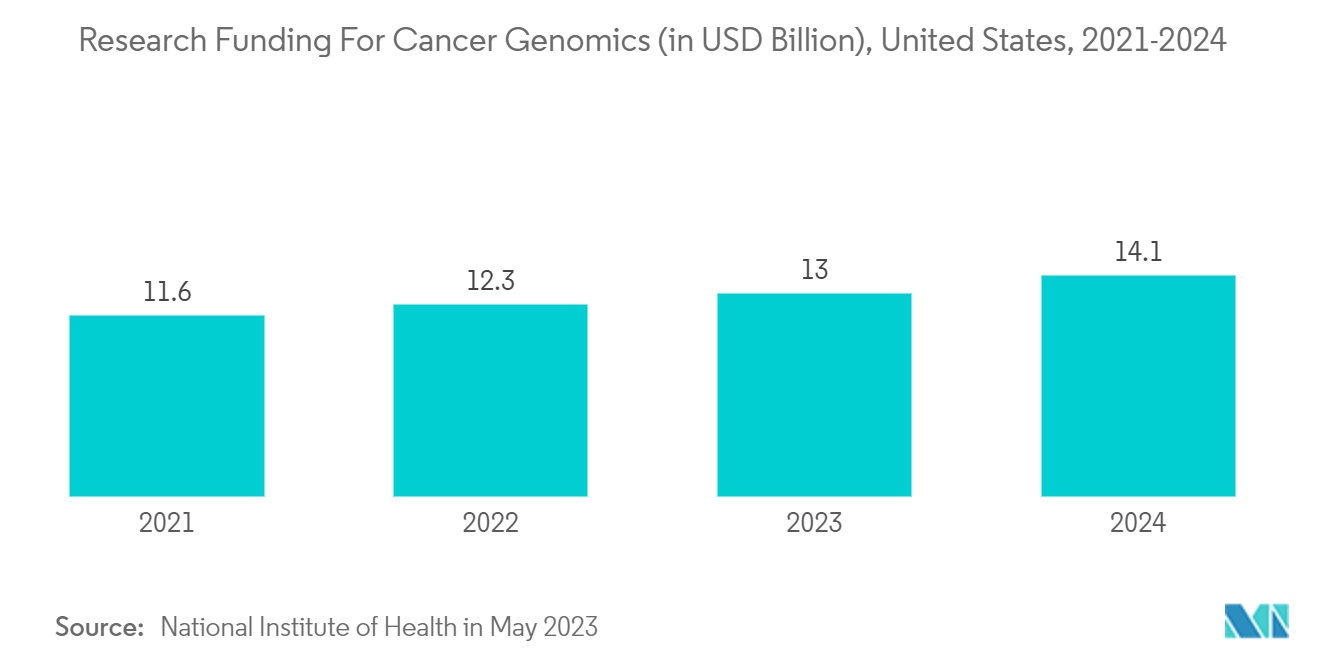
North America is Expected to Hold Significant Market Share Over the Forecast Period
The North American spatial OMICS market is experiencing significant growth, fueled by extensive research and development efforts. Prestigious academic institutions, biotechnology companies, and pharmaceutical corporations are making substantial investments in spatial OMICS technology, focusing on precision diagnostics and drug development. In addition, the growing burden of chronic diseases and strategic activities adopted by the market players is expected to contribute to market growth over the forecast period.
According to the 2024 statistics published by the American Cancer Society (ACS), the incidence of cancer is projected to increase from 1.93 million in 2023 to 2.00 million in 2024, an increase of more than 60 thousand cases within two years, demonstrating a rapid growth in the incidence of cancer in the United States. Similarly, as per the Canadian Cancer Statistics 2023 report, about 239.2 thousand new cancer cases were reported in 2023 in Canada, compared to 233.9 thousand in 2022. Thus, the growing burden of cancer is expected to create demand for drug research and manufacturing services, contributing to segmental growth. Hence, the high prevalence of cancer is anticipated to utilize molecular genomics tests to identify the severity, thereby boosting market growth over the forecast period.
The region fosters strategic partnerships and collaborations between academia, industry, and healthcare providers, facilitating knowledge exchange, resource sharing, and joint research efforts in spatial OMICS. Collaborative initiatives boost technology development, data standardization, and market penetration of spatial OMICS solutions. For instance, in April 2023, Bio-Techne and Lunaphore formed a strategic alliance to develop a fully automated spatial multiomics solution. The alliance is intended to create a method for simultaneous identification of protein and RNA biomarkers on a single slide, which would offer panel design flexibility and facilitate comprehensive disease research.
The region's strong focus on research and development drives advancements in spatial omics technologies, including spatial transcriptomics, spatial proteomics, and spatial genomics. These advancements attract investments, collaborations, and commercialization efforts, leading to market growth. For instance, in October 2023, Pixelgen Technologies reported the closure of Series A financing of approximately USD 7.3 million to support the commercial expansion of the spatial proteomics tool for analyzing cell surface proteins on single cells in order to transform drug discovery and basic science.
Additionally, in September 2023, Multiomics CRO Psomagen launched Spatial Biology services for 10X Genomics Xenium. This platform reshapes spatial biology, enabling researchers worldwide to analyze the interplay of genes and proteins within their native tissue context. This marked a pivotal moment in the scientific community's access to spatial genomics.
Thus, the growing burden of cancer, research and development initiatives, strategic collaboration, and product launches are expected to contribute to the market’s growth over the forecast period.
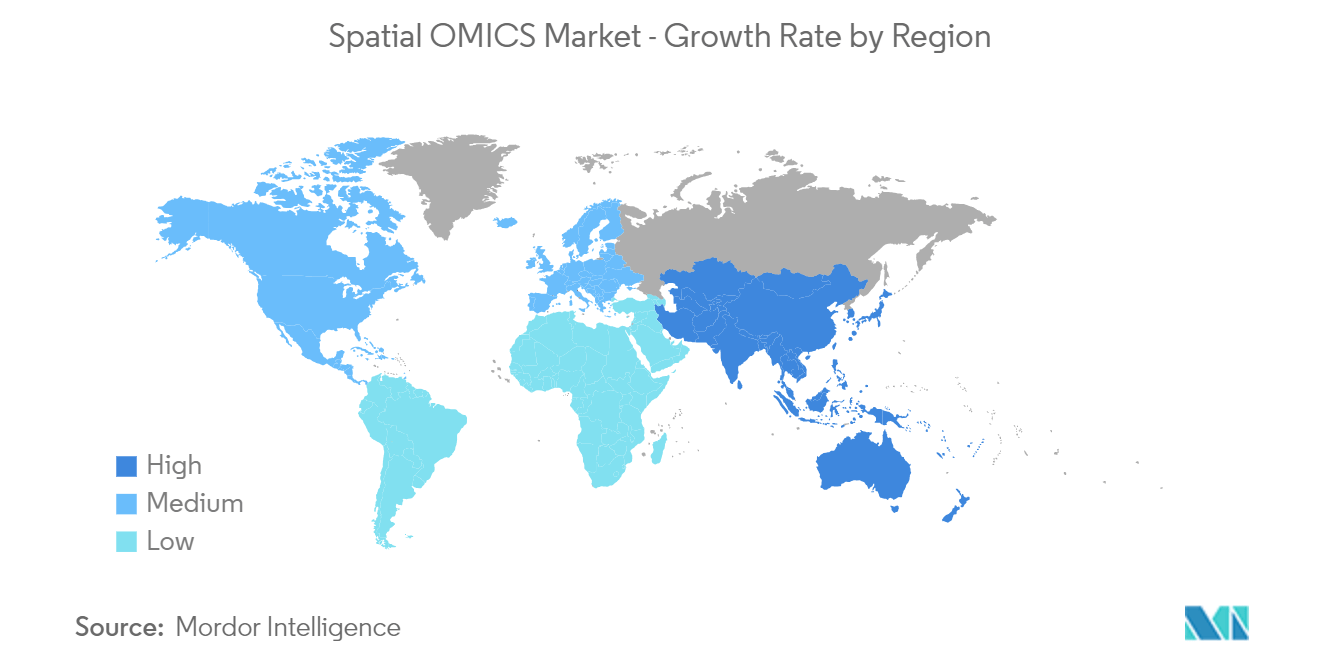
Spatial OMICS Industry Overview
The market is highly competitive due to the presence of large numbers of players. The competitive landscape of the spatial OMICS market stimulates innovation, product differentiation, and market expansion strategies among industry players, contributing to its growth. Market players engaged in collaborative initiatives accelerate technology development, data standardization, and market penetration of spatial OMICS solutions. Some of the market players are 10x Genomics, Dovetail Genomics (Cantata Bio.), S2 Genomics Inc., NanoString Technologies Inc., Seven Bridges Genomics, PerkinElmer Inc., Bio-Techne, Bruker, Akoya Biosciences Inc. and among others.
Spatial OMICS Market Leaders
-
10x Genomics
-
PerkinElmer, Inc
-
Bruker
-
Akoya Biosciences, Inc.
-
Bio-Techne
*Disclaimer: Major Players sorted in no particular order
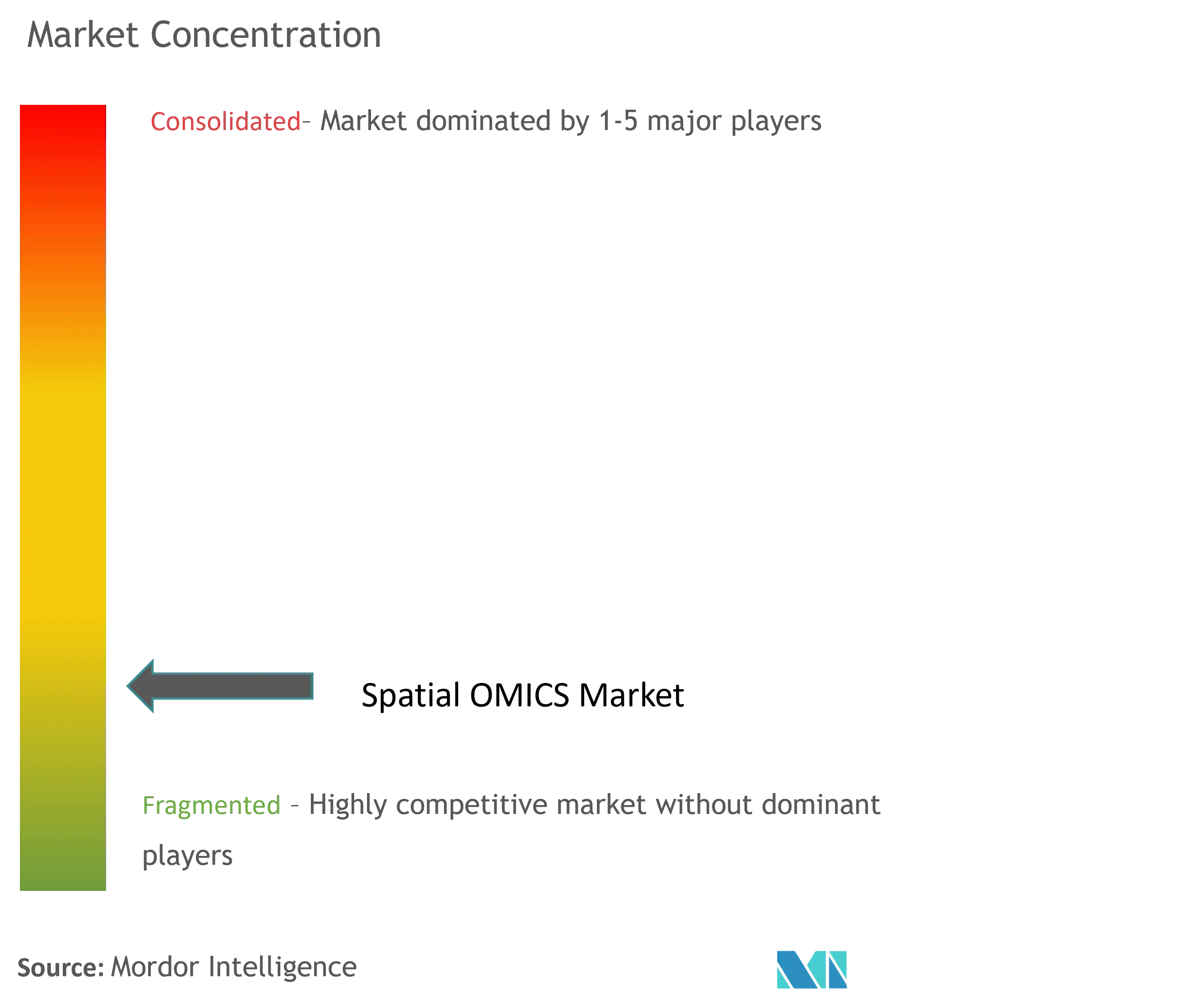
Spatial OMICS Market News
- March 2024: 10x Genomics initiated commercial distribution of its eagerly anticipated Visium HD Spatial Gene Expression instrument. Visium HD is engineered to empower researchers with the ability to thoroughly analyze FFPE tissue samples by quantifying spatial gene expression across the entire transcriptome at a single-cell resolution.
- January 2024: SimBioSys obtained 510(k) clearance from the US Food and Drug Administration (FDA). This clearance permits the marketing of TumorSight Viz, a software application designed to generate three-dimensional spatial visualizations of breast tumors.
Spatial OMICS Market Report - Table of Contents
1. INTRODUCTION
- 1.1 Study Assumptions and Market Definition
- 1.2 Scope of the Study
2. RESEARCH METHODOLOGY
3. EXECUTIVE SUMMARY
4. MARKET DYNAMICS
- 4.1 Market Overview
-
4.2 Market Drivers
- 4.2.1 High Burden of Cancer and Genetic Diseases
- 4.2.2 Advancement in Omics Technologies and Increasing Demand for Personalized Medicine
- 4.2.3 Rising Government Initiatives and Funding Activities
-
4.3 Market Restraints
- 4.3.1 High Cost of Instruments and Data Storage
- 4.3.2 Complex Regulatory Requirement and Standardization Issues
-
4.4 Porter's Five Forces Analysis
- 4.4.1 Threat of New Entrants
- 4.4.2 Bargaining Power of Buyers/Consumers
- 4.4.3 Bargaining Power of Suppliers
- 4.4.4 Threat of Substitute Products
- 4.4.5 Intensity of Competitive Rivalry
5. MARKET SEGMENTATION (Market Size by Value - USD)
-
5.1 By Technology
- 5.1.1 Spatial Transcriptomics
- 5.1.2 Spatial Genomics
- 5.1.3 Spatial Proteomics
-
5.2 By Product
- 5.2.1 Instruments
- 5.2.2 Consumables
- 5.2.3 Software
-
5.3 By Sample
- 5.3.1 Formalin-Fixed Paraffin-Embedded (FFPE)
- 5.3.2 Fresh Frozen
-
5.4 By Application
- 5.4.1 Diagnostics
- 5.4.2 Translation Research
- 5.4.3 Drug Discovery and Development
- 5.4.4 Single Cell Analysis
- 5.4.5 Cell Biology
- 5.4.6 Other
-
5.5 By End User
- 5.5.1 Academic & Translational Research Institutes
- 5.5.2 Pharmaceutical & Biotechnology Companies
- 5.5.3 Others
-
5.6 Geography
- 5.6.1 North America
- 5.6.1.1 United States
- 5.6.1.2 Canada
- 5.6.1.3 Mexico
- 5.6.2 Europe
- 5.6.2.1 Germany
- 5.6.2.2 United Kingdom
- 5.6.2.3 France
- 5.6.2.4 Italy
- 5.6.2.5 Spain
- 5.6.2.6 Rest of Europe
- 5.6.3 Asia-Pacific
- 5.6.3.1 China
- 5.6.3.2 Japan
- 5.6.3.3 India
- 5.6.3.4 Australia
- 5.6.3.5 South Korea
- 5.6.3.6 Rest of Asia-Pacific
- 5.6.4 Rest of the World
6. COMPETITIVE LANDSCAPE
-
6.1 Company Profiles
- 6.1.1 10x Genomics
- 6.1.2 Dovetail Genomics (Cantata Bio.)
- 6.1.3 S2 Genomics Inc.
- 6.1.4 NanoString Technologies Inc.
- 6.1.5 Seven Bridges Genomics
- 6.1.6 PerkinElmer Inc.
- 6.1.7 Bio-Techne
- 6.1.8 Danaher Corporation
- 6.1.9 Ionpath Inc.
- 6.1.10 Bruker
- 6.1.11 Akoya Biosciences Inc.
- 6.1.12 Biognosys
- *List Not Exhaustive
7. MARKET OPPORTUNITIES AND FUTURE TRENDS
** Subject To AvailablitySpatial OMICS Industry Segmentation
As per the scope of the report, Spatial OMICS encompasses technologies that merge molecular profiling with spatial information, facilitating the analysis of biological samples in their native spatial environment.
The spatial OMICS market is segmented by technology, products, workflow, sample, end user, application, and geography. By technology, the market is segmented into spatial transcriptomics, spatial genomics, and spatial proteomics. By products, the market is segmented into instruments, consumables, and software. By sample, the market is segmented into formalin-fixed paraffin-embedded (FFPE) and fresh frozen. By application, the market is segmented into diagnostics, translation research, drug discovery and development, single-cell analysis, cell biology, and others. By end user, the market is segmented into academic & translational research institutes, pharmaceutical & biotechnology companies, and others. By geography, the market is segmented into North America, Europe, Asia-Pacific, and the Rest of the World. The report also covers the estimated market sizes and trends for 17 countries across major regions globally. For each segment, the market sizing and forecasts were made on the basis of value (USD).
| By Technology | Spatial Transcriptomics | |
| Spatial Genomics | ||
| Spatial Proteomics | ||
| By Product | Instruments | |
| Consumables | ||
| Software | ||
| By Sample | Formalin-Fixed Paraffin-Embedded (FFPE) | |
| Fresh Frozen | ||
| By Application | Diagnostics | |
| Translation Research | ||
| Drug Discovery and Development | ||
| Single Cell Analysis | ||
| Cell Biology | ||
| Other | ||
| By End User | Academic & Translational Research Institutes | |
| Pharmaceutical & Biotechnology Companies | ||
| Others | ||
| Geography | North America | United States |
| Canada | ||
| Mexico | ||
| Geography | Europe | Germany |
| United Kingdom | ||
| France | ||
| Italy | ||
| Spain | ||
| Rest of Europe | ||
| Geography | Asia-Pacific | China |
| Japan | ||
| India | ||
| Australia | ||
| South Korea | ||
| Rest of Asia-Pacific | ||
| Geography | Rest of the World |
Spatial OMICS Market Research FAQs
How big is the Spatial OMICS Market?
The Spatial OMICS Market size is expected to reach USD 335.60 million in 2024 and grow at a CAGR of 10.60% to reach USD 553.5 million by 2029.
What is the current Spatial OMICS Market size?
In 2024, the Spatial OMICS Market size is expected to reach USD 335.60 million.
Who are the key players in Spatial OMICS Market?
10x Genomics, PerkinElmer, Inc, Bruker, Akoya Biosciences, Inc. and Bio-Techne are the major companies operating in the Spatial OMICS Market.
Which is the fastest growing region in Spatial OMICS Market?
Asia Pacific is estimated to grow at the highest CAGR over the forecast period (2024-2029).
Which region has the biggest share in Spatial OMICS Market?
In 2024, the North America accounts for the largest market share in Spatial OMICS Market.
What years does this Spatial OMICS Market cover, and what was the market size in 2023?
In 2023, the Spatial OMICS Market size was estimated at USD 300.03 million. The report covers the Spatial OMICS Market historical market size for years: 2021, 2022 and 2023. The report also forecasts the Spatial OMICS Market size for years: 2024, 2025, 2026, 2027, 2028 and 2029.
Spatial OMICS Industry Report
Statistics for the 2024 Spatial OMICS market share, size and revenue growth rate, created by Mordor Intelligence™ Industry Reports. Spatial OMICS analysis includes a market forecast outlook for 2024 to 2029 and historical overview. Get a sample of this industry analysis as a free report PDF download.



